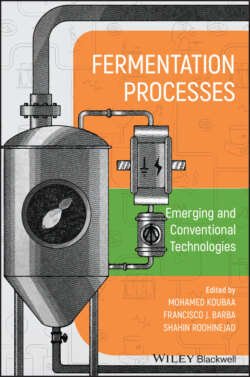Читать книгу Fermentation Processes: Emerging and Conventional Technologies - Группа авторов - Страница 28
1.3.2 Fungi
ОглавлениеFungi are eukaryotic microorganisms that could be divided into filamentous hyphae (also called molds) and unicellular fungi (also called yeasts). A relatively low number of filamentous fungi are used at industrial scale in bioprocesses (e.g. Acremonium, Agaricus, Aureobasidium, Aspergillus, Claviceps, Coniothyrium, Curvularia, Cylindrocarpon, Fusarium, Lentinus, Mortierella, Mucor, Paecilomyces, Penicillium, Rhizomucor, Rhizopus, Sclerotium, Trametes, Trichoderma, and Trichosporon). Filamentous fungi are chemoheterotrophs and nonphotosynthetic. Most of them secrete a wide variety of hydrolytic enzymes (e.g. cellulose, amylase, xylanase, etc.) (de Souza and de Oliveira Magalhães 2010; Payne et al. 2015; Polizeli et al. 2005) that can degrade different polymers (e.g. lignocellulosic materials) into smaller molecules (e.g. monosaccharides, disaccharides, etc.), which are easily absorbed and metabolized. Filamentous fungi germinate from either individual spore or a fragment of hyphae when exposed to suitable environmental conditions (e.g. pH, temperature, etc.). The length of hyphae can increase rapidly at rates reaching several μm/min (Waites et al. 2001). Further reading about the filamentous fungi can be found in Quintanilla et al. (2015).
Yeasts are unicellular fungi (Figure 1.6b) with great industrial importance, notably S. cerevisiae, the major yeast used in alcoholic fermentation (see Chapter 2). Yeasts are heterotrophic, and most of them can grow in the presence and absence of O2 (facultative anaerobes), unlike most fungi. Yeasts are not nutritionally demanding as a relatively simple medium composition (e.g. reduced carbon sources, organic and inorganic nitrogen sources such as urea and ammonium salts, respectively, some minerals, and water) allows them to multiply. Sometimes, vitamins (e.g. biotin) are also supplemented to allow the optimal growth of the yeasts. Yeasts of industrial importance include the genera of Blakeslea, Candida, Hansenula, Kluyveromyces, Pachysolen, Phaffia, Pichia, Rhodotorula, Saccharomyces, Xanthophyllomyces, Yarrowia, and Zygosaccharomyces (Waites et al. 2001). Thousands of examples have been reported in the literature to describe the potential of these yeasts in different industrial sectors (Defavari do Nascimento and Pickering 2017; Drévillon et al. 2018; Koubaa et al. 2020; Peris et al. 2018).
The selection of a microbial species to perform a bioprocess does not only require its ability to synthesize a potentially useful compound or to carry out a particular metabolic pathway. Indeed, most of the industries seek strains that can meet other important criteria, which will allow the optimization of the biological process and maximize profitability. Such criteria include:
1 The ability of the strain to grow quickly on inexpensive organic substrates (e.g. molasses, corn liquor, whey, etc.);
2 The ability of the strain to perform in a simple and fast way the sought‐after transformations with high efficiency and a minimum of energy consumption;
3 The strain must be genetically stable (low mutation rate) to maintain its production capacity over time;
4 The strain must be specialized in the synthesis of products that are easy to extract and separate; and
5 The strain should not be pathogenic.
Wild‐type strains are usually unable to meet the above‐mentioned criteria. Indeed, they often have a limited performance that must be amplified to reach the industrial requirements. In fact, wild‐type microorganisms have usually metabolic regulation mechanisms, often of the negative feedback type, allowing them to produce naturally only the quantity of enzymes and metabolites they need to survive in a competitive environment. By short‐circuiting these mechanisms with genetic modifications, more productive microorganisms could be generated. Besides, the wild strain may have certain undesirable characteristics that can also be modified, such as sensitivity to a bacteriophage, the trend to generate a lot of foam in a liquid medium, or the synthesis of a by‐product that is difficult to eliminate during the downstream purification steps. In all cases, there is an interest in implementing a genetic improvement program for the strain involving the use of mutations or recombinant DNA technology (Figure 1.7). Further reading about microbial transformation techniques can be found in Han (2004). The review of the literature showed hundreds of examples of genetic modifications of microbial strains toward their use in industrial bioprocesses. The major metabolic engineering achievements in the recent years include microbial production of amino acids (e.g. L‐valine, L‐threonine, L‐lysine, and L‐arginine), bulk chemicals (e.g. 1,4‐butanediol, 1,4‐diaminobutane, 1,5‐diaminopentane, 1,3‐propanediol, butanol, isobutanol, and succinic acid), and drugs (e.g. artemisinin) (Lee and Kim 2015).
Figure 1.7 Diagram of a typical gene cloning methodology and cell banking system preparation.
